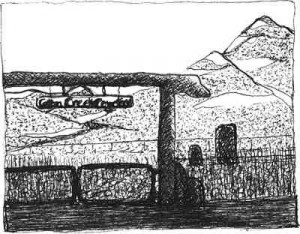Column by George Sibley
Community – February 2006 – Colorado Central Magazine
CAN YOU BE a real town if you don’t have a movie theater?
That’s a question Gunnison has been asking itself, with the consensus being that the answer is no.
For several years now, Gunnison has been without a movie theater. It was not always so. When I first moved to the Upper Gunnison Valley back in the mid- 60s, Gunnison had a pretty typical mid- 20th- century “movie palace” right on Main Street, and a drive- in theater just west of town (the screen still stands, more or less). Both of those Gunnison theaters closed in the 1970s, but were replaced by a “duplex” out on the north edge of town. But a few years ago, the owners of that building called it quits and sold the building to an evangelical church.
The Gunnison Arts Center makes a stab at filling the gap with a “Tuesday Night at the Movies” showing of independent films, but basically, for that good old American movie- going experience, you have to drive 30 miles to Crested Butte — although the theater there was also closed most of this past year — or 60 miles to Montrose.
This is deemed a bad thing. Back in 1966, Larry McMurtry wrote a book, “The Last Picture Show,” that Peter Bogdanovich made into a movie in 1971. The basic story they told was the death- by- boredom of small- town America — a long lingering literary death that began with Sinclair Lewis and Sherwood Anderson in the 1920s, advanced through Grace Metalius and others in the 1950s, and supposedly takes its last breaths in Anarene, Texas, around the closing down of the local movie theater. With no movie theater, the argument goes, there’s no more reason for the young folk to stay.
This strikes me as one of those cultural myths that wants a closer look. I’ve been thinking about it because recently — until I quit the Economic Development Board here in the Gunnison valley over such nonsense — I was more or less forced to think about it by the City of Gunnison, an ED funder. The City Manager at the time seemed to think that the key to economic development for the Gunnison end of the valley was a movie theater. So we advertised, and we met with various people, honest and dishonest, but we couldn’t find anyone, especially anyone with experience, willing to start a movie theater in Gunnison. The track record of the previous theaters spoke loudly.
But does that mean Gunnison is a bust, doomed to die of boredom, like Anarene, Texas? Actually, the valley seems to be doing pretty well culturally. There’s so much going on in the valley that sometimes I find myself sighing with relief on the rare evening when there’s neither a cultural activity nor a meeting I ought to go to. There are two healthy community theaters in the valley; the college does 4- 5 theater productions every year and a whole host of musical evenings; the Gunnison Art Center’s dance program has something like 300 people involved in classes; the Crested Butte Music Festival runs through the summer; and there are traveling shows brought in by the college and the upvalley and downvalley arts organizations. And that doesn’t include all the public- school programs that a lot of us have to go to, whether we want to or not. Nor all the sports events, nor the people’s passion for outdoors activities. We are not a cultural dead spot.
SO WHAT DON’T we have due to the absence of a movie theater in Gunnison? Well, we don’t have a cultural medium where we can go to marvel at how good entertainment technicians are getting at appearing to be blowing things up, wrecking expensive stuff, simulating sex, showing eco- porn, and otherwise nurturing community values. No, to get that stuff we have to rent the videos or DVDs and take them home to our living room (or bedroom in our case, a concession to a tendency to drift off in the second half). But we do watch that stuff. With four video stores in the valley, we’re probably watching more movies than ever. We just watch them at home, which may be where passive entertainment should be experienced, if at all. Like sex, passivity is out of the closet, but can’t we keep it in the bedroom?
The fact is, the movie theater might best be considered a transitional phenomenon in the conversion of public culture into private entertainment — a phenomenon most thoroughly realized in television. We tend to think of film as a form of theater, but it really isn’t. Theater evolved out of community- level dramaturgy, people trying to figure out what they were doing (Greek root of “drama”) by seeing (Greek root of “theater”) interpretations of it created by some of their own. Real theater is very interactive; if the audience isn’t an active participant, with or against the players, the production suffers accordingly.
By that definition, movies are not real theater. The audience can cheer or sleep, but the presentation is not affected a whit; your attendance just racks up another few bucks on the only scorecard that counts for movies. What’s communal about sitting in the dark with a bunch of people you can’t really see, watching something where your only vote about its meaning or quality was cast when you bought your ticket? I’d rather cast that meaningless vote in the comfort of home.
MAYBE MORE IMPORTANT, rather than being a marker of community vitality, movies probably do a lot to undermine community cohesiveness. While there are exceptions — Salt of the Earth and The Milagro Beanfield War come to mind — most movies apply marvelous technology and celebrity acting (often very good) to take us away from the concerns of community. Movies are basically about escaping to some larger, more exciting and classier world that, in our saner moments, we know probably doesn’t really exist.
Maybe we need that escapism. I just watched (in my bedroom) “Sullivan’s Travels,” a strange movie by one of Hollywood’s postwar mavericks, Preston Sturges. The protagonist in the movie is a 1930s movie director who is tired of making escapist comedies, and wants to make a “serious movie about human suffering.” When his producers point out that he doesn’t really know anything about human suffering, he goes out in bum drag and tries to suffer — an agenda at which he achieves some success, mostly overbalanced by meeting up with Veronica Lake. But what he discovers is that what the people who are truly suffering really want is something to make them laugh and temporarily escape their troubles! Or so he says.
I’m not saying there’s not a need for movies (although books probably fulfill that same need as well). But the lack of a public place to view a private medium is hardly a measure of community vitality. I visited my hometown, back in Pennsylvania, last summer, and was heartened to see that the old movie theater on the main drag, where I wasted many a Saturday afternoon and random evening, is no longer the sporting goods store it was converted into when videos became popular; it is now the community theater. Maybe they only do Neil Simon shows — but at least it’s the people who live there trying to involve each other where they are. Community might just start with the last picture show.
George Sibley writes, teaches, and organizes in Gunnison.


